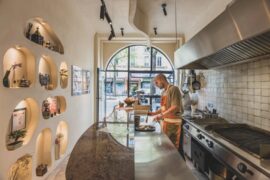Champagne is probably the most famous French wine. Many people who have little to no knowledge about wines certainly know champagne is a symbol of luxury. Every movie showcasing rich people must contain at least one bottle of champagne. Yet, when you think of December in France, champagne is, next to Bûche de Noël, a staple and an indispensable part of Christmas, not to mention New Year’s Eve. Now, of course, not every champagne is delicious, but this little guide will help you pick the right one for ’tis the season to get bubbly.

About the wine
Champagne is a sparkling wine from the Champagne region in the northeast of France. Without a doubt, its status comes partly from the fact it can be produced exclusively there and according to methods precisely defined by the law. It includes the traditional method (méthode traditionnelle) of sparkling wine production. It’s the most expensive and time-consuming method of sparkling winemaking but is also considered the best in terms of quality.
Champagnes are made out of three types of grapes. Chardonnay, known for more citrus flavors, is the only white grape out of the three. Pinot Noir has red fruit flavors, and Pinot Meunier, characterized by more apple flavor, adds roundness to the wine. The sweetness scale of champagne ranges from brut (dry) through sec (moderately dry) to doux (sweet). Yet, over 90% of champagnes are brut. Champagne is to be served chilled, ideally in a flute glass. But in case you don’t have one, a white wine glass is also an option.

Style
- Blanc de Blancs – 100% chardonnay grapes
- Blanc de Noirs – pinot noir and pinot meunier grapes (separately or as a blend)
- Rosé – chardonnay with a bit of pinot noir and/or pinor meunier grapes
Aging
- Non-vintage – must be aged at least 15 months
- Vintage – must be aged at least 3 years
- Cuvée Prestige – aged for about 6-7 years, considered to be the best ones on the market, making them the most expensive ones

Pairings
The French usually serve champagne with foie gras for Christmas dinner. However, due to ethical reasons, many refrain from having it. Champagne perfectly pairs up with cheese and meat platters. But if you are vegan, you can always opt for fried veggies and mushrooms as a replacement. Falafel and homemade fries make great snacks too.
Still, the best advice regarding drinking champagne comes from Lily Bollinger, the head of the Bollinger Champagne from 1941 till 1971: “I drink champagne when I’m happy and when I’m sad. Sometimes I drink it when I’m alone. When I have company, I consider it obligatory. I trifle with it if I’m not hungry and drink it when I am. Otherwise, I never touch it — unless I’m thirsty.”

Interesting Facts
- In the beginning, fizz in wine was a haphazard result of cold temperatures, and winemakers considered it undesirable.
- Bubbles were known and enjoyed in England slightly before Dom Pierre Perignon introduced the traditional method at the abbey of Hautvilliers in 1697.
- Champagne region is also famous for the city of Reims, where Kings of France were crowned between 1027 and 1825. Nowadays, it also plays a significant role in champagne marketing.
- Reims is a perfect weekend trip destination as it is only a 1.5-hours drive from Paris.
- The most luxurious champagne brands are: Dom Perignon, Krug, Bollinger, Perrier Jouet, Veuve Cliquot, Cristal, Armand de Brignac.
- Winston Churchill’s quote about champagne: “I could not live without champagne. In victory, I deserve it in defeat, I need it” is usually misattributed to Napoleon Bonaparte.

Source: Dom Pérignon





Comments are closed.